MERCEDES-BENZ G-Class 2015 W463 Owner's Manual
Manufacturer: MERCEDES-BENZ, Model Year: 2015, Model line: G-Class, Model: MERCEDES-BENZ G-Class 2015 W463Pages: 350, PDF Size: 6.44 MB
Page 331 of 350
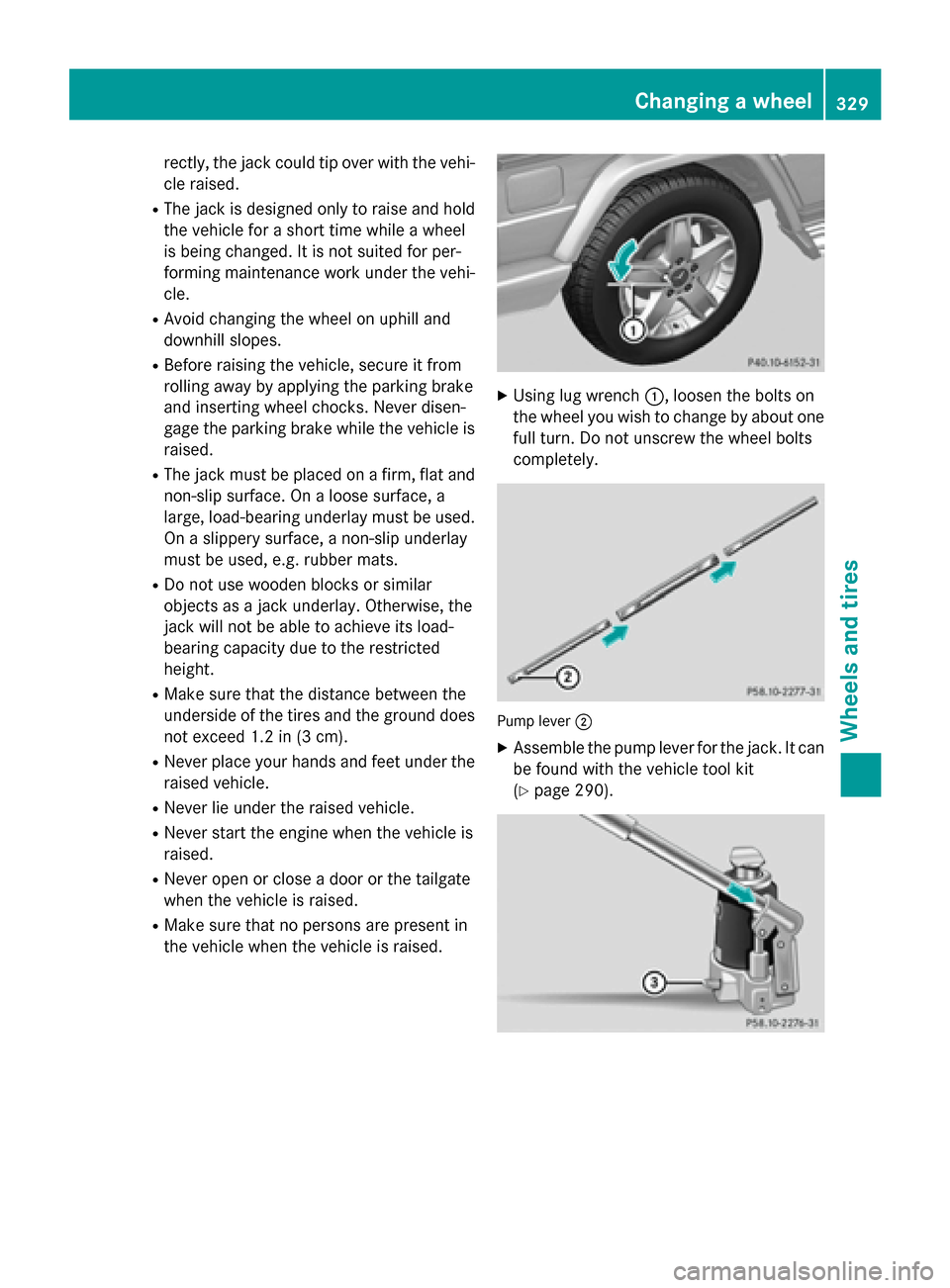
rectly, the jack could tip over with the vehi-
cle raised.
R The jack is designed only to raise and hold
the vehicle for a short time while a wheel
is being changed. It is not suited for per-
forming maintenance work under the vehi- cle.
R Avoid changing the wheel on uphill and
downhill slopes.
R Before raising the vehicle, secure it from
rolling away by applying the parking brake
and inserting wheel chocks. Never disen-
gage the parking brake while the vehicle is raised.
R The jack must be placed on a firm, flat and
non-slip surface. On a loose surface, a
large, load-bearing underlay must be used.
On a slippery surface, a non-slip underlay
must be used, e.g. rubber mats.
R Do not use wooden blocks or similar
objects as a jack underlay. Otherwise, the
jack will not be able to achieve its load-
bearing capacity due to the restricted
height.
R Make sure that the distance between the
underside of the tires and the ground does
not exceed 1.2 in (3 cm).
R Never place your hands and feet under the
raised vehicle.
R Never lie under the raised vehicle.
R Never start the engine when the vehicle is
raised.
R Never open or close a door or the tailgate
when the vehicle is raised.
R Make sure that no persons are present in
the vehicle when the vehicle is raised. X
Using lug wrench :, loosen the bolts on
the wheel you wish to change by about one full turn. Do not unscrew the wheel bolts
completely. Pump lever
;
X Assemble the pump lever for the jack. It can
be found with the vehicle tool kit
(Y page 290). Changing a wheel
329Wheels and tires Z
Page 332 of 350
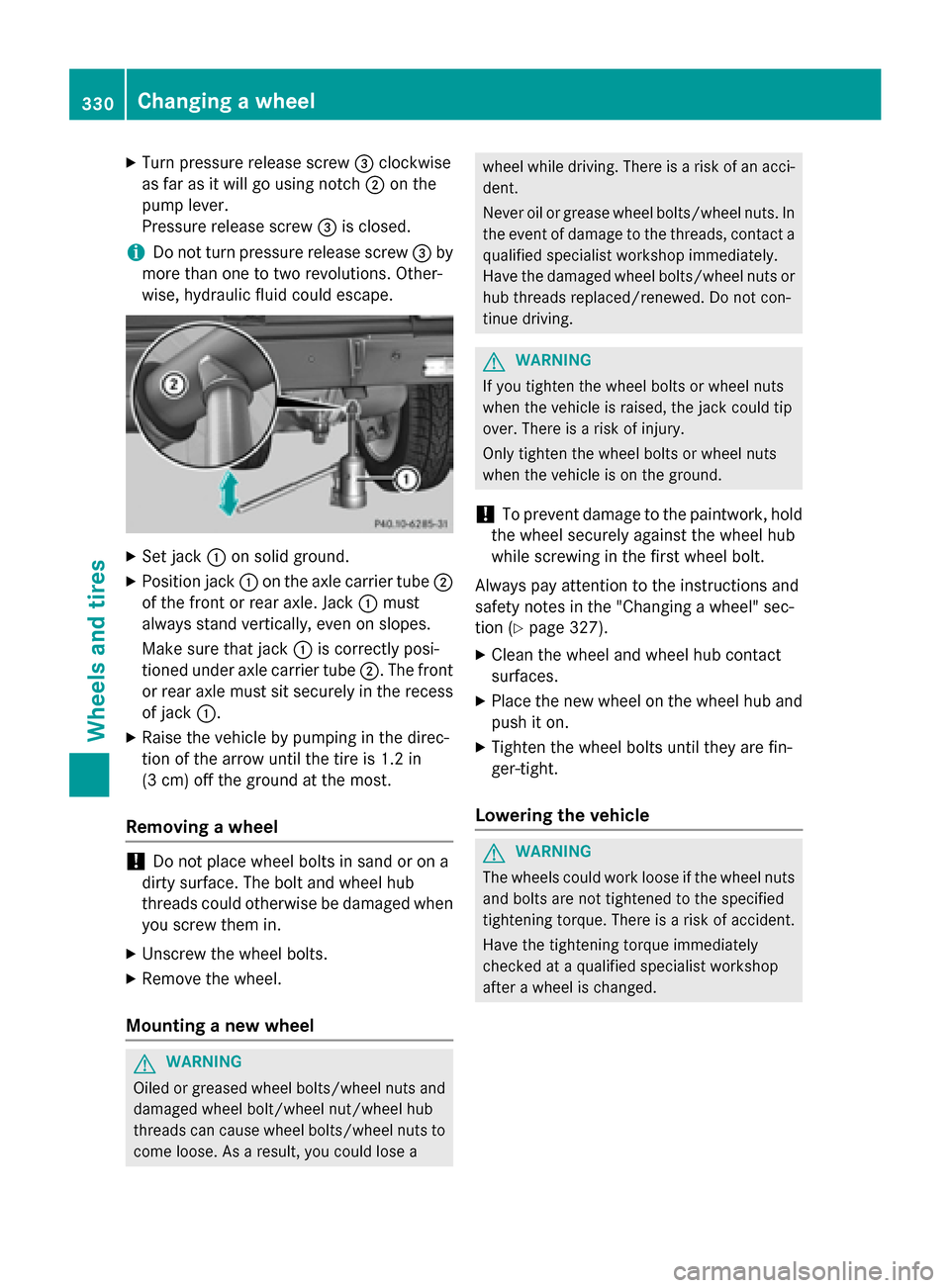
X
Turn pressure release screw =clockwise
as far as it will go using notch ;on the
pump lever.
Pressure release screw =is closed.
i Do not turn pressure release screw
=by
more than one to two revolutions. Other-
wise, hydraulic fluid could escape. X
Set jack :on solid ground.
X Position jack :on the axle carrier tube ;
of the front or rear axle. Jack :must
always stand vertically, even on slopes.
Make sure that jack :is correctly posi-
tioned under axle carrier tube ;. The front
or rear axle must sit securely in the recess of jack :.
X Raise the vehicle by pumping in the direc-
tion of the arrow until the tire is 1.2 in
(3 cm) off the ground at the most.
Removing a wheel !
Do not place wheel bolts in sand or on a
dirty surface. The bolt and wheel hub
threads could otherwise be damaged when you screw them in.
X Unscrew the wheel bolts.
X Remove the wheel.
Mounting a new wheel G
WARNING
Oiled or greased wheel bolts/wheel nuts and damaged wheel bolt/wheel nut/wheel hub
threads can cause wheel bolts/wheel nuts to come loose. As a result, you could lose a wheel while driving. There is a risk of an acci-
dent.
Never oil or grease wheel bolts/wheel nuts. In the event of damage to the threads, contact a
qualified specialist workshop immediately.
Have the damaged wheel bolts/wheel nuts or hub threads replaced/renewed. Do not con-
tinue driving. G
WARNING
If you tighten the wheel bolts or wheel nuts
when the vehicle is raised, the jack could tip
over. There is a risk of injury.
Only tighten the wheel bolts or wheel nuts
when the vehicle is on the ground.
! To prevent damage to the paintwork, hold
the wheel securely against the wheel hub
while screwing in the first wheel bolt.
Always pay attention to the instructions and
safety notes in the "Changing a wheel" sec-
tion (Y page 327).
X Clean the wheel and wheel hub contact
surfaces.
X Place the new wheel on the wheel hub and
push it on.
X Tighten the wheel bolts until they are fin-
ger-tight.
Lowering the vehicle G
WARNING
The wheels could work loose if the wheel nuts and bolts are not tightened to the specified
tightening torque. There is a risk of accident.
Have the tightening torque immediately
checked at a qualified specialist workshop
after a wheel is changed. 330
Changing a wheelWheels and tires
Page 333 of 350
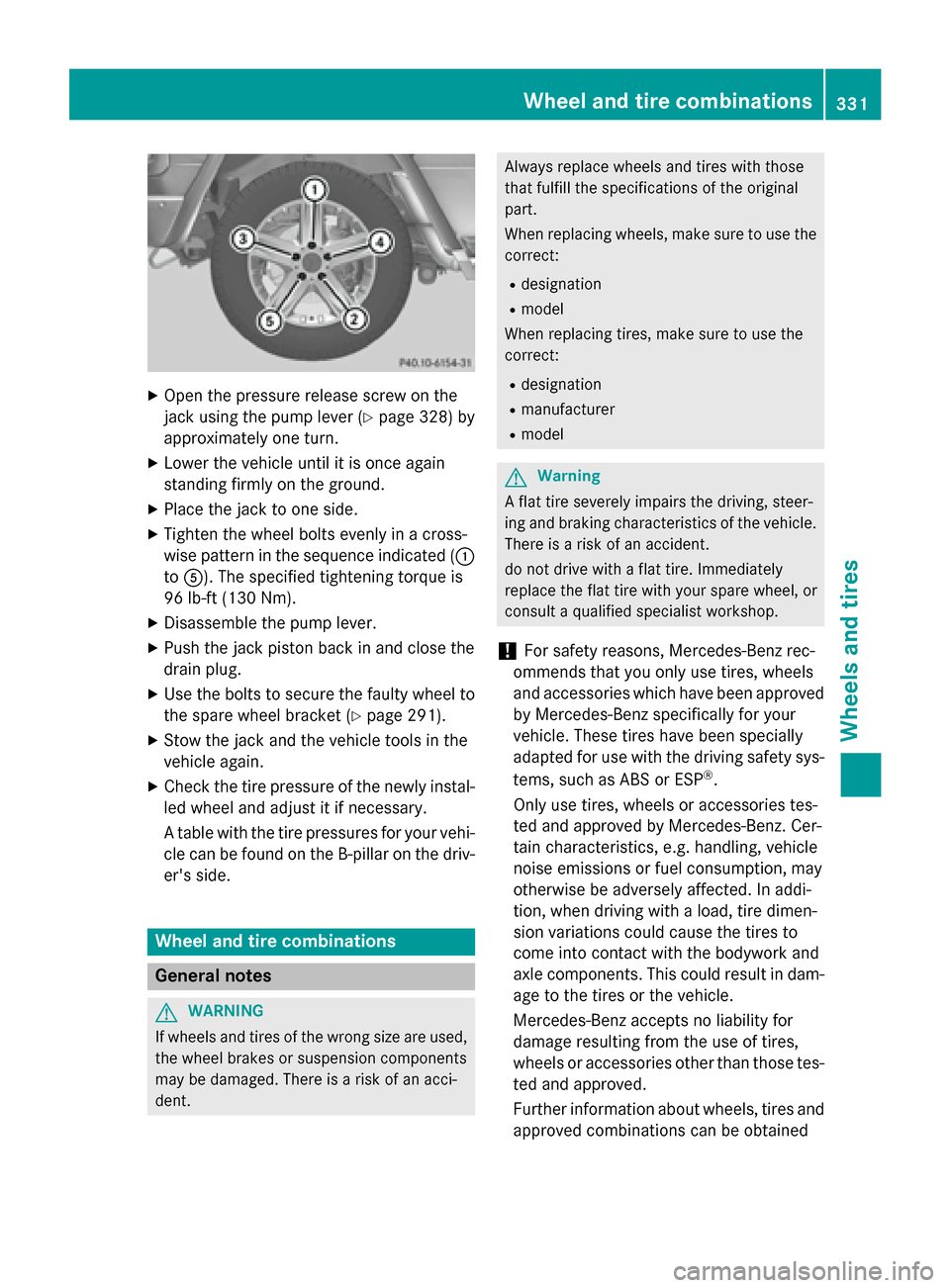
X
Open the pressure release screw on the
jack using the pump lever (Y page 328) by
approximately one turn.
X Lower the vehicle until it is once again
standing firmly on the ground.
X Place the jack to one side.
X Tighten the wheel bolts evenly in a cross-
wise pattern in the sequence indicated ( :
to A). The specified tightening torque is
96 lb-ft (130 Nm).
X Disassemble the pump lever.
X Push the jack piston back in and close the
drain plug.
X Use the bolts to secure the faulty wheel to
the spare wheel bracket (Y page 291).
X Stow the jack and the vehicle tools in the
vehicle again.
X Check the tire pressure of the newly instal-
led wheel and adjust it if necessary.
A table with the tire pressures for your vehi-cle can be found on the B-pillar on the driv-
er's side. Wheel and tire combinations
General notes
G
WARNING
If wheels and tires of the wrong size are used, the wheel brakes or suspension components
may be damaged. There is a risk of an acci-
dent. Always replace wheels and tires with those
that fulfill the specifications of the original
part.
When replacing wheels, make sure to use the
correct:
R designation
R model
When replacing tires, make sure to use the
correct:
R designation
R manufacturer
R model G
Warning
A flat tire severely impairs the driving, steer-
ing and braking characteristics of the vehicle.
There is a risk of an accident.
do not drive with a flat tire. Immediately
replace the flat tire with your spare wheel, or
consult a qualified specialist workshop.
! For safety reasons, Mercedes-Benz rec-
ommends that you only use tires, wheels
and accessories which have been approved by Mercedes-Benz specifically for your
vehicle. These tires have been specially
adapted for use with the driving safety sys-
tems, such as ABS or ESP ®
.
Only use tires, wheels or accessories tes-
ted and approved by Mercedes-Benz. Cer-
tain characteristics, e.g. handling, vehicle
noise emissions or fuel consumption, may
otherwise be adversely affected. In addi-
tion, when driving with a load, tire dimen-
sion variations could cause the tires to
come into contact with the bodywork and
axle components. This could result in dam-
age to the tires or the vehicle.
Mercedes-Benz accepts no liability for
damage resulting from the use of tires,
wheels or accessories other than those tes- ted and approved.
Further information about wheels, tires and
approved combinations can be obtained Wheel and tire combinations
331Wheels and tires Z
Page 334 of 350
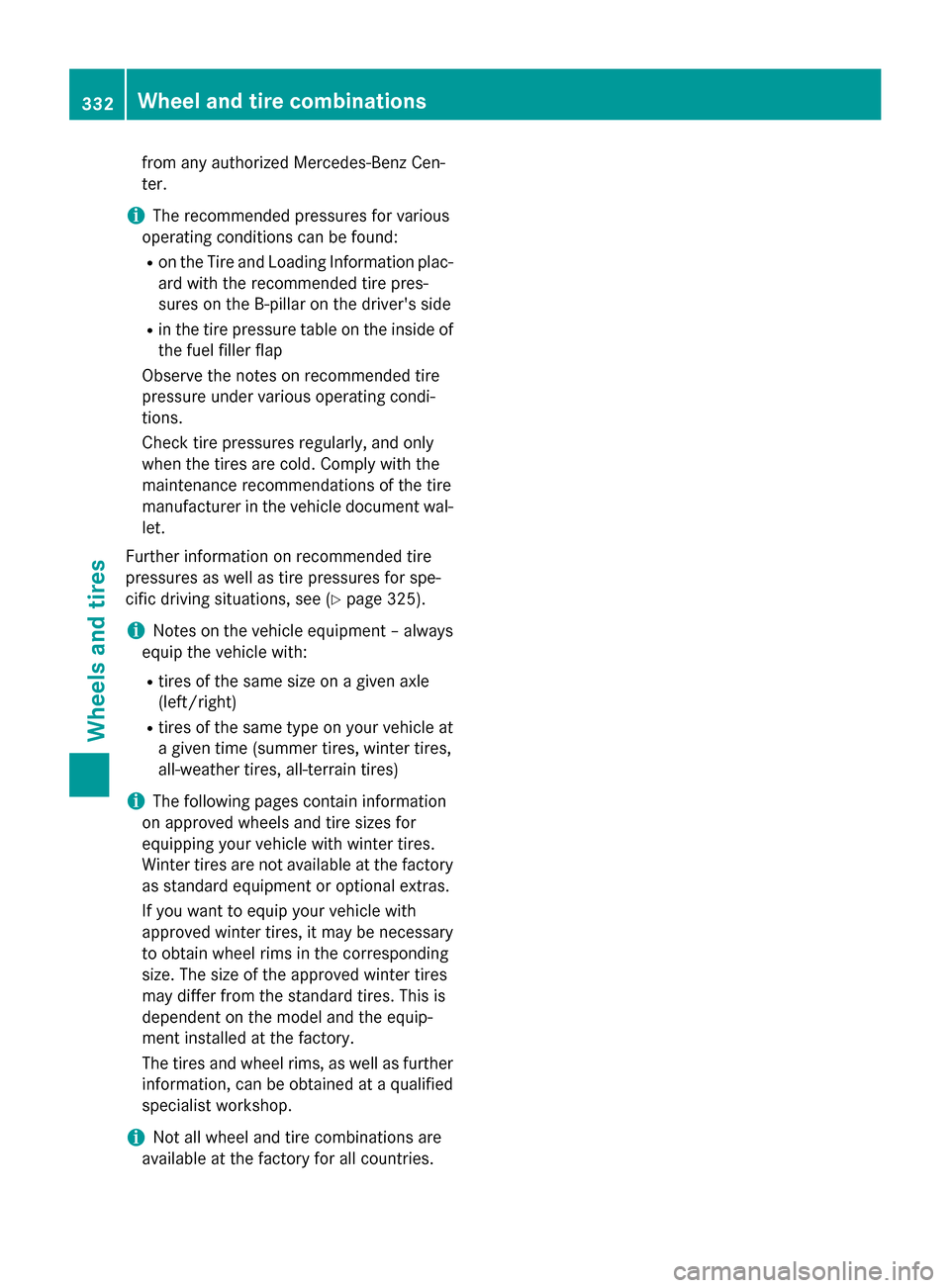
from any authorized Mercedes-Benz Cen-
ter.
i The recommended pressures for various
operating conditions can be found:
R on the Tire and Loading Information plac-
ard with the recommended tire pres-
sures on the B-pillar on the driver's side
R in the tire pressure table on the inside of
the fuel filler flap
Observe the notes on recommended tire
pressure under various operating condi-
tions.
Check tire pressures regularly, and only
when the tires are cold. Comply with the
maintenance recommendations of the tire
manufacturer in the vehicle document wal- let.
Further information on recommended tire
pressures as well as tire pressures for spe-
cific driving situations, see (Y page 325).
i Notes on the vehicle equipment – always
equip the vehicle with:
R tires of the same size on a given axle
(left/right)
R tires of the same type on your vehicle at
a given time (summer tires, winter tires,
all-weather tires, all-terrain tires)
i The following pages contain information
on approved wheels and tire sizes for
equipping your vehicle with winter tires.
Winter tires are not available at the factory as standard equipment or optional extras.
If you want to equip your vehicle with
approved winter tires, it may be necessary
to obtain wheel rims in the corresponding
size. The size of the approved winter tires
may differ from the standard tires. This is
dependent on the model and the equip-
ment installed at the factory.
The tires and wheel rims, as well as further
information, can be obtained at a qualified
specialist workshop.
i Not all wheel and tire combinations are
available at the factory for all countries. 332
Wheel and tire combinationsWheels and tires
Page 335 of 350
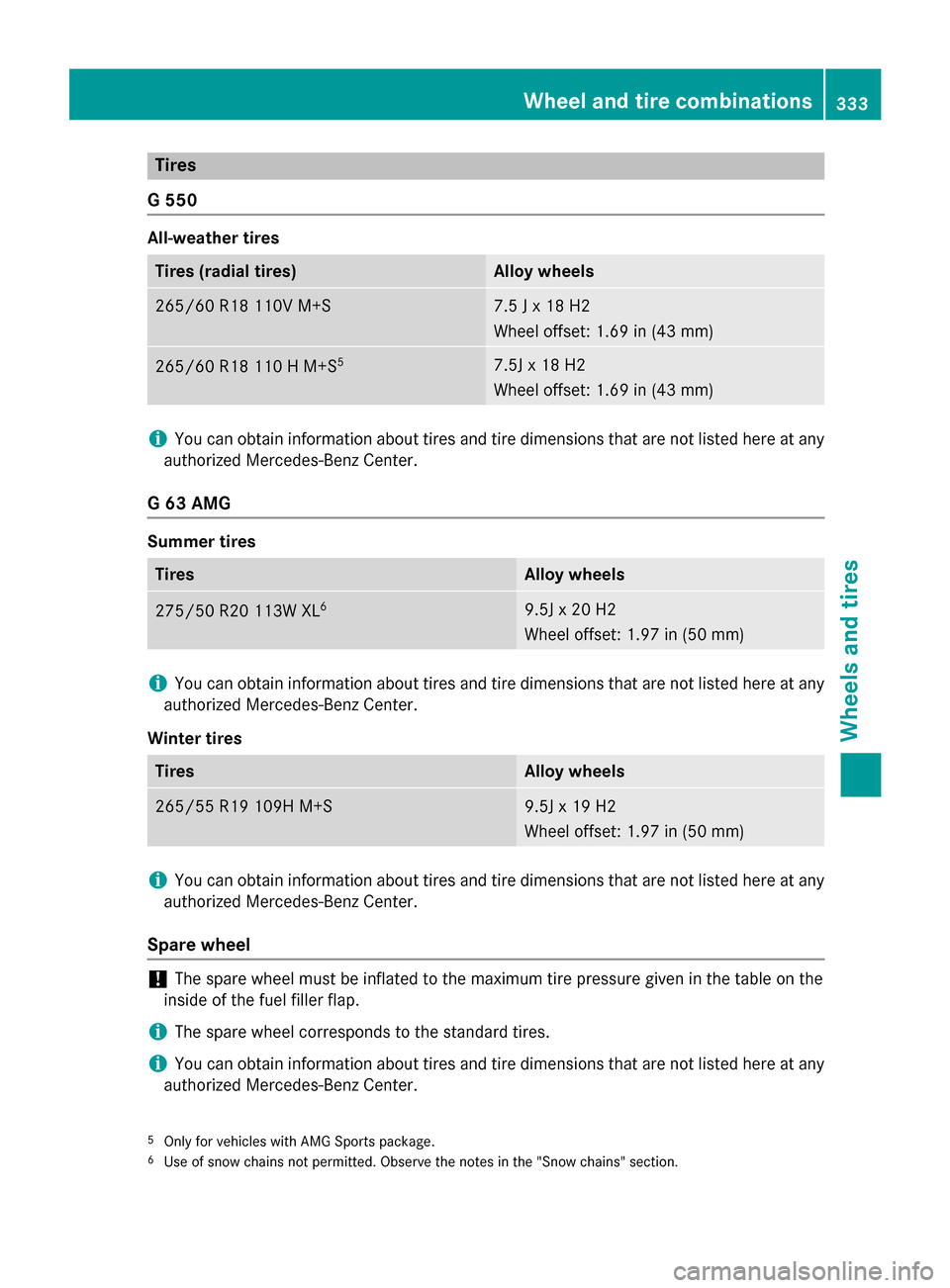
Tires
G 550 All-weather tires
Tires (radial tires) Alloy wheels
265/60 R18 110V M+S 7.5 J x 18 H2
Wheel offset: 1.69 in (43 mm)
265/60 R18 110
HM+S 5 7.5J x 18 H2
Wheel offset: 1.69 in (43 mm)
i
You can obtain information about tires and tire dimensions that are not listed here at any
authorized Mercedes-Benz Center.
G 63 AMG Summer tires
Tires Alloy wheels
275/50 R20 113W XL
6 9.5J x 20 H2
Wheel offset: 1.97 in (50 mm)
i
You can obtain information about tires and tire dimensions that are not listed here at any
authorized Mercedes-Benz Center.
Winter tires Tires Alloy wheels
265/55 R19 109H M+S 9.5J x 19 H2
Wheel offset: 1.97 in (50 mm)
i
You can obtain information about tires and tire dimensions that are not listed here at any
authorized Mercedes-Benz Center.
Spare wheel !
The spare wheel must be inflated to the maximum tire pressure given in the table on the
inside of the fuel filler flap.
i The spare wheel corresponds to the standard tires.
i You can obtain information about tires and tire dimensions that are not listed here at any
authorized Mercedes-Benz Center.
5 Only for vehicles with AMG Sports package.
6 Use of snow chains not permitted. Observe the notes in the "Snow chains" section. Wheel and tire combinations
333Wheels and tires Z
Page 336 of 350

334
Page 337 of 350
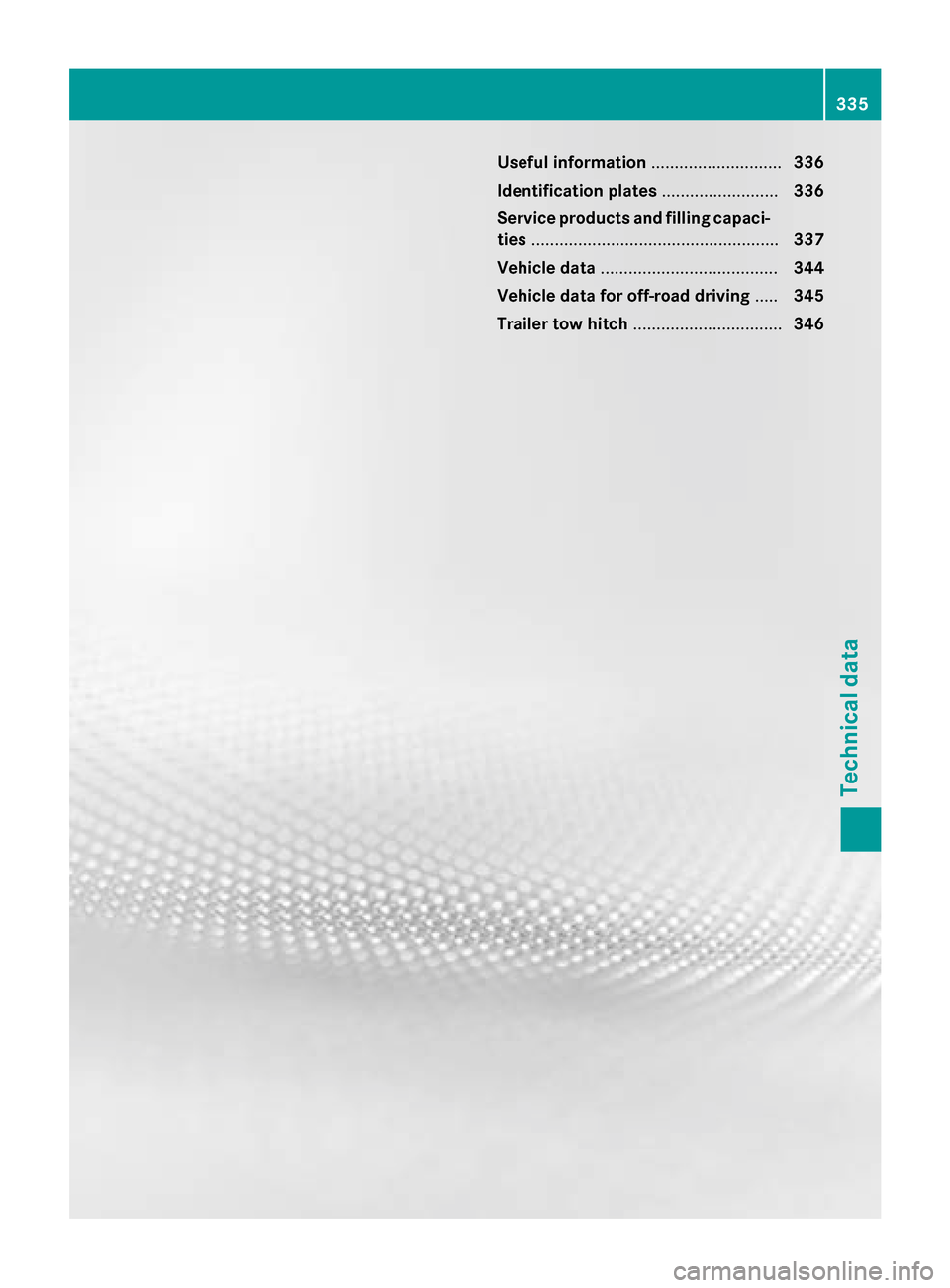
Useful information
............................336
Identification plates .........................336
Service products and filling capaci- ties ..................................................... 337
Vehicle data ...................................... 344
Vehicle data for off-road driving .....345
Trailer tow hitch ................................ 346 335Technical data
Page 338 of 350
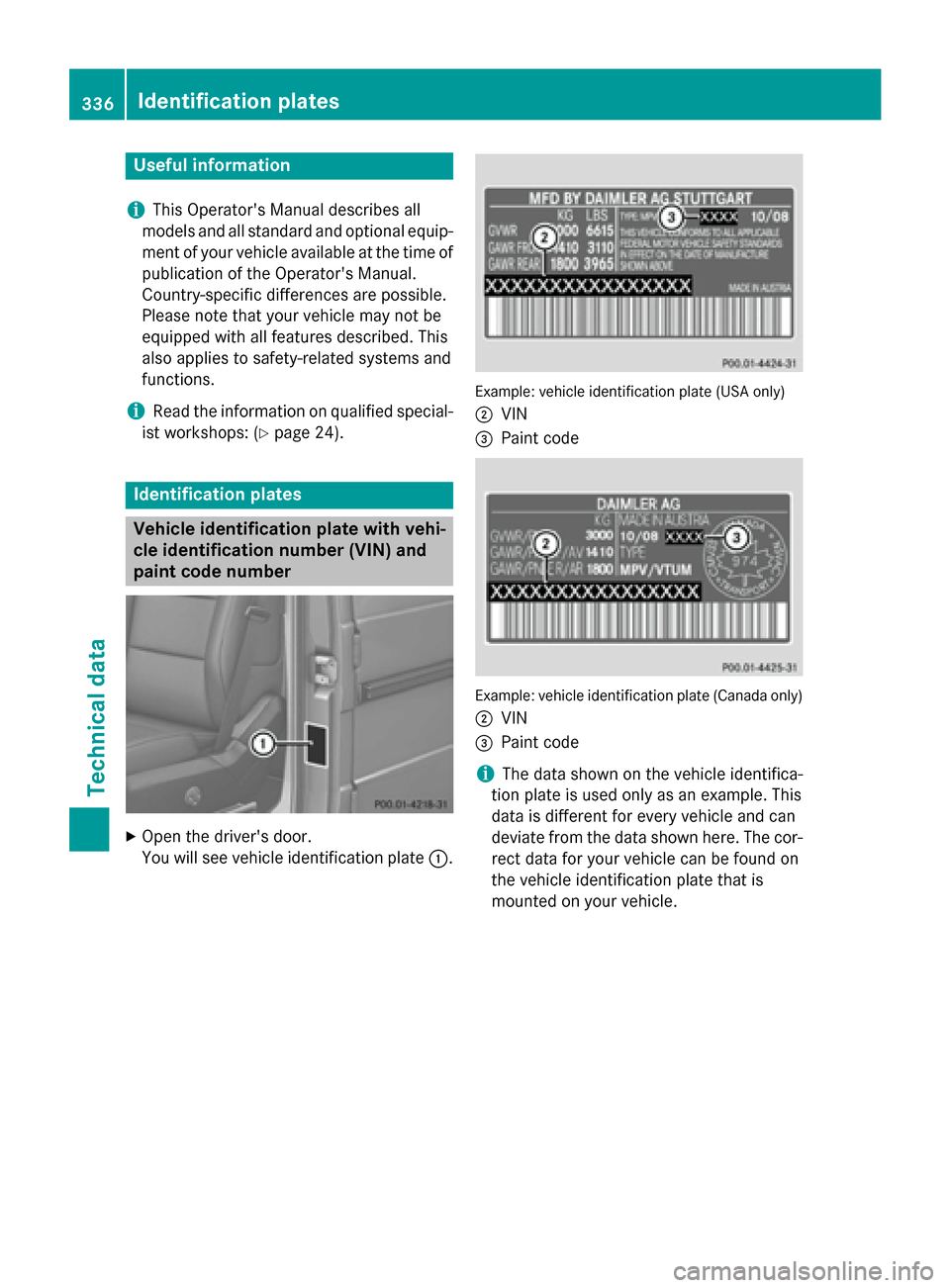
Useful information
i This Operator's Manual describes all
models and all standard and optional equip- ment of your vehicle available at the time of
publication of the Operator's Manual.
Country-specific differences are possible.
Please note that your vehicle may not be
equipped with all features described. This
also applies to safety-related systems and
functions.
i Read the information on qualified special-
ist workshops: (Y page 24). Identification plates
Vehicle identification plate with vehi-
cle identification number (VIN) and
paint code number
X
Open the driver's door.
You will see vehicle identification plate :. Example: vehicle identification plate (USA only)
; VIN
= Paint code Example: vehicle identification plate (Canada only)
; VIN
= Paint code
i The data shown on the vehicle identifica-
tion plate is used only as an example. This
data is different for every vehicle and can
deviate from the data shown here. The cor-
rect data for your vehicle can be found on
the vehicle identification plate that is
mounted on your vehicle. 336
Identification platesTechnical data
Page 339 of 350
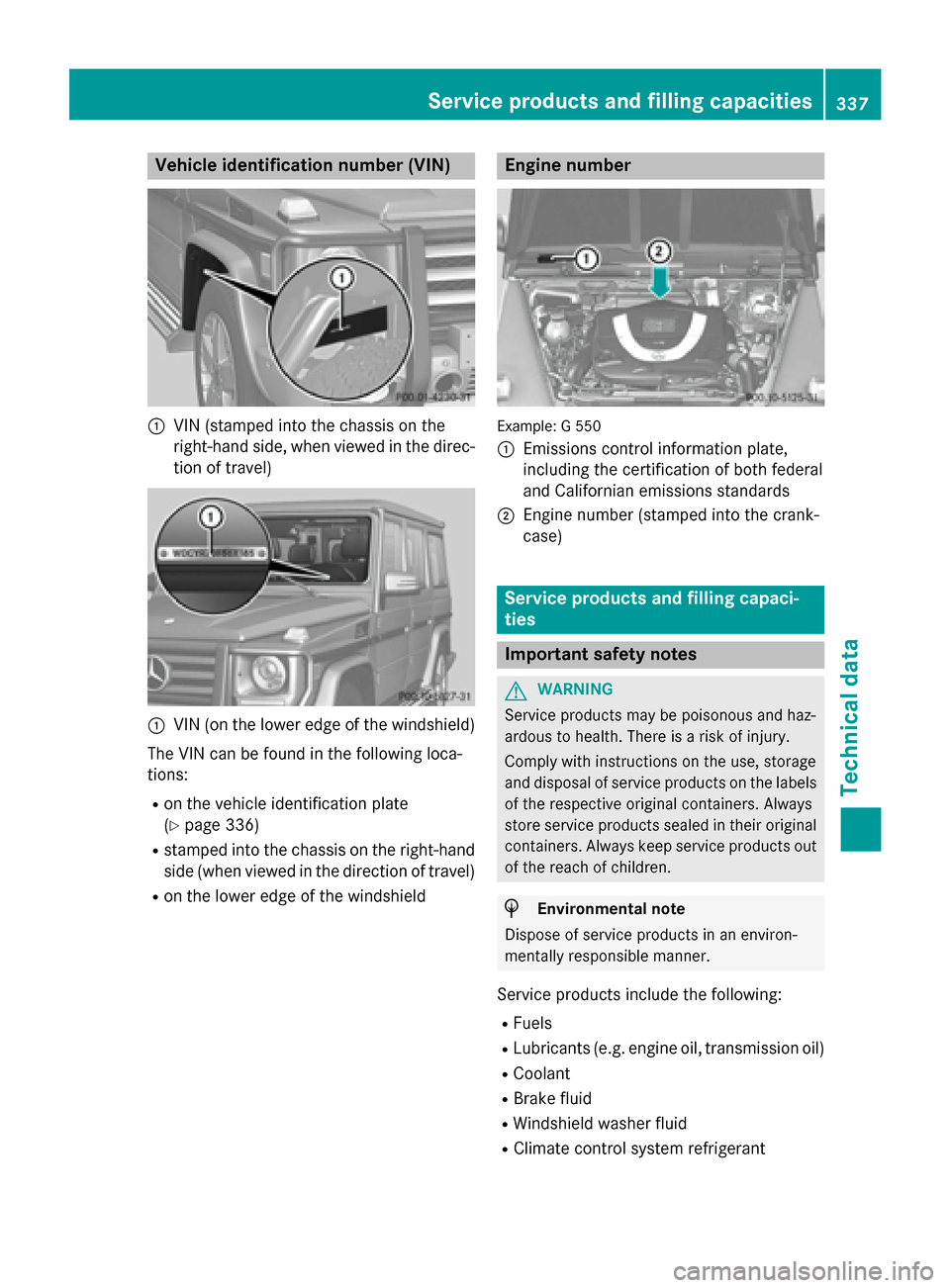
Vehicle identification number (VIN)
:
VIN (stamped into the chassis on the
right-hand side, when viewed in the direc- tion of travel) :
VIN (on the lower edge of the windshield)
The VIN can be found in the following loca-
tions:
R on the vehicle identification plate
(Y page 336)
R stamped into the chassis on the right-hand
side (when viewed in the direction of travel)
R on the lower edge of the windshield Engine number
Example: G 550
:
Emissions control information plate,
including the certification of both federal
and Californian emissions standards
; Engine number (stamped into the crank-
case) Service products and filling capaci-
ties
Important safety notes
G
WARNING
Service products may be poisonous and haz-
ardous to health. There is a risk of injury.
Comply with instructions on the use, storage
and disposal of service products on the labels of the respective original containers. Always
store service products sealed in their original containers. Always keep service products out
of the reach of children. H
Environmental note
Dispose of service products in an environ-
mentally responsible manner.
Service products include the following:
R Fuels
R Lubricants (e.g. engine oil, transmission oil)
R Coolant
R Brake fluid
R Windshield washer fluid
R Climate control system refrigerant Service products and filling capacities
337Technical data Z
Page 340 of 350
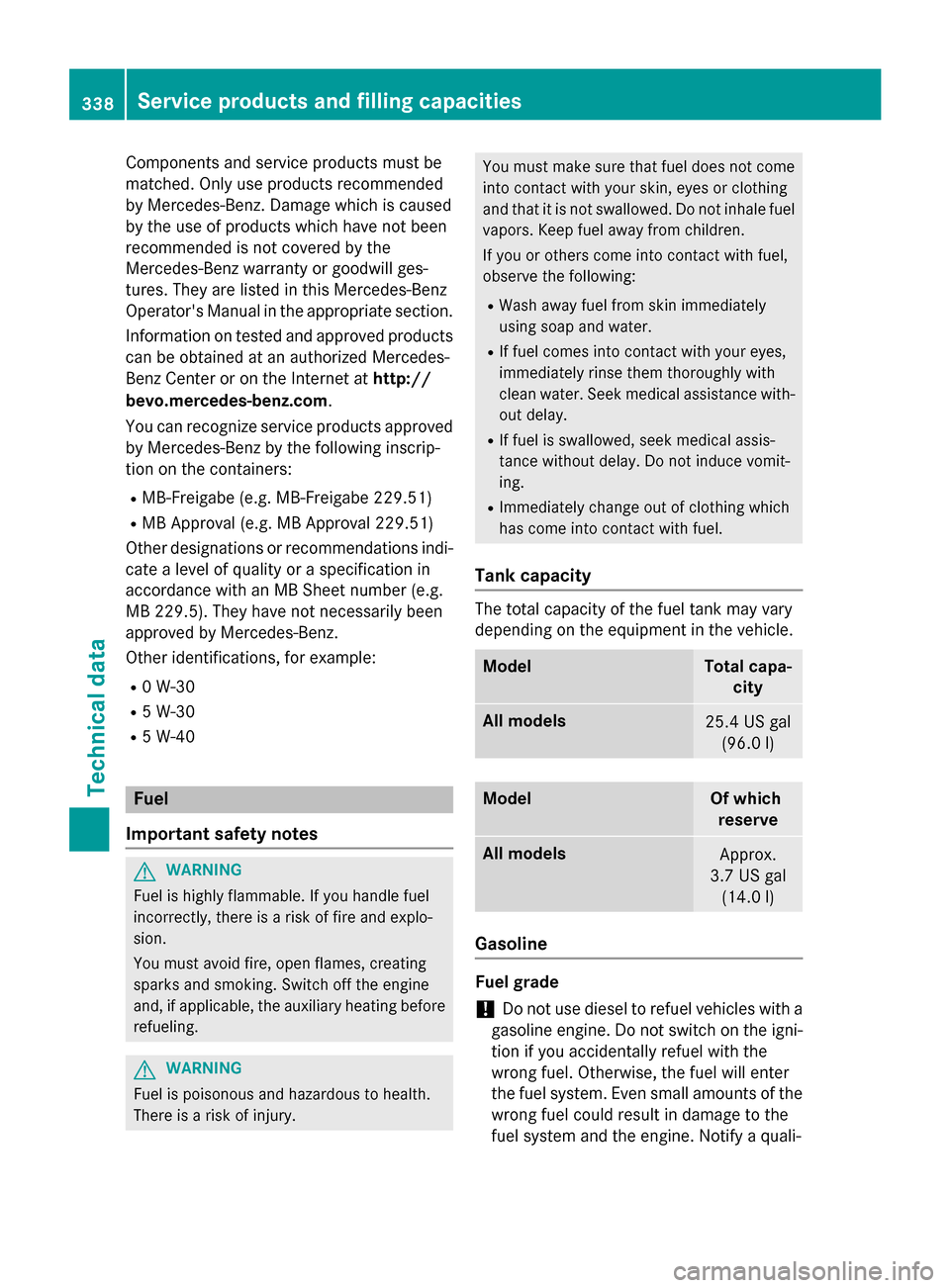
Components and service products must be
matched. Only use products recommended
by Mercedes-Benz. Damage which is caused
by the use of products which have not been
recommended is not covered by the
Mercedes-Benz warranty or goodwill ges-
tures. They are listed in this Mercedes-Benz
Operator's Manual in the appropriate section.
Information on tested and approved products can be obtained at an authorized Mercedes-
Benz Center or on the Internet at http://
bevo.mercedes-benz.com .
You can recognize service products approved
by Mercedes-Benz by the following inscrip-
tion on the containers:
R MB-Freigabe (e.g. MB-Freigabe 229.51)
R MB Approval (e.g. MB Approval 229.51)
Other designations or recommendations indi- cate a level of quality or a specification in
accordance with an MB Sheet number (e.g.
MB 229.5). They have not necessarily been
approved by Mercedes-Benz.
Other identifications, for example:
R 0 W-30
R 5 W-30
R 5 W-40 Fuel
Important safety notes G
WARNING
Fuel is highly flammable. If you handle fuel
incorrectly, there is a risk of fire and explo-
sion.
You must avoid fire, open flames, creating
sparks and smoking. Switch off the engine
and, if applicable, the auxiliary heating before refueling. G
WARNING
Fuel is poisonous and hazardous to health.
There is a risk of injury. You must make sure that fuel does not come
into contact with your skin, eyes or clothing
and that it is not swallowed. Do not inhale fuel
vapors. Keep fuel away from children.
If you or others come into contact with fuel,
observe the following:
R Wash away fuel from skin immediately
using soap and water.
R If fuel comes into contact with your eyes,
immediately rinse them thoroughly with
clean water. Seek medical assistance with-
out delay.
R If fuel is swallowed, seek medical assis-
tance without delay. Do not induce vomit-
ing.
R Immediately change out of clothing which
has come into contact with fuel.
Tank capacity The total capacity of the fuel tank may vary
depending on the equipment in the vehicle.
Model Total capa-
city All models
25.4 US gal
(96.0 l) Model Of which
reserve All models
Approx.
3.7 US gal (14.0 l) Gasoline
Fuel grade
!
Do not use diesel to refuel vehicles with a
gasoline engine. Do not switch on the igni- tion if you accidentally refuel with the
wrong fuel. Otherwise, the fuel will enter
the fuel system. Even small amounts of the
wrong fuel could result in damage to the
fuel system and the engine. Notify a quali- 338
Service products and filling capacitiesTechnical data